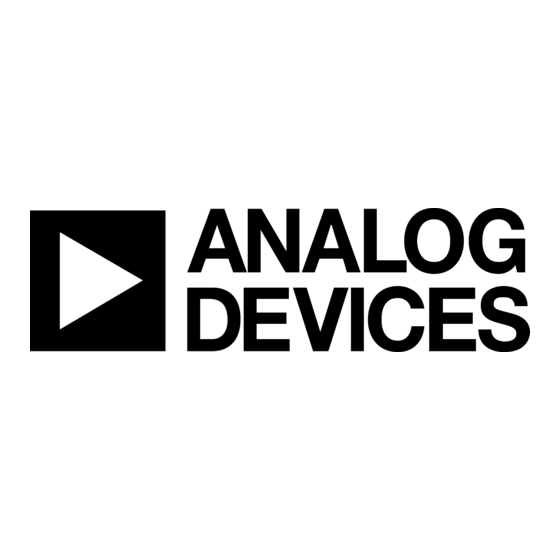Table of Contents
Advertisement
Quick Links
One Technology Way • P.O. Box 9106 • Norwood, MA 02062-9106, U.S.A. • Tel: 781.329.4700 • Fax: 781.461.3113 • www.analog.com
Evaluation Board for the 2 A/3 A, 20 V, Nonsynchronous Step-Down Regulators
FEATURES
Wide input voltage range: 3.0 V to 20 V
Maximum load current
2 A for ADP2302
3 A for ADP2303
±1.5% output accuracy over temperature
Output voltage down to 0.8 V
700 kHz switching frequency
Current-mode control architecture
Automatic PFM/PWM mode
Precision enable pin with hysteresis
Integrated high-side MOSFET
Integrated bootstrap diode
Internal compensation and soft start
Power-good output
Undervoltage lockout (UVLO)
Overcurrent protection (OCP)
Thermal shutdown (TSD)
8-lead SOIC package with exposed paddle
PLEASE SEE THE LAST PAGE FOR AN IMPORTANT
WARNING AND LEGAL TERMS AND CONDITIONS.
ADP2302/ADP2303 EVALUATION BOARD
Figure 1. ADP2302/ADP2303 Evaluation Board
Rev. 0 | Page 1 of 12
Evaluation Board User Guide
GENERAL DESCRIPTION
The
ADP2302/ADP2303
are 2 A/3 A, 20 V, nonsynchronous
step-down, dc-to-dc regulators with an integrated power MOSFET
in a SOIC package with an exposed paddle. The ADP2302/
ADP2303 evaluation boards are complete buck regulator solutions
that allow users to evaluate the performance of the regulators.
The ADP2302/ADP2303 integrated soft-start circuitry prevents
inrush current at power-up. The power-good output indicates
that the output voltage is regulated within tolerance, and it can
be used to sequence devices that have an enable input. The
precision enable feature allows the part to be easily sequenced
from external supplies. Other key features include undervoltage
lockout (UVLO), output overvoltage protection (OVP), thermal
shutdown (TSD), and overcurrent protection (OCP). Full details on
the ADP2302/ADP2303 are provided in the ADP2302/ADP2303
data sheet available from Analog Devices, Inc., which should be
consulted in conjunction with this user guide.
UG-189
Advertisement
Table of Contents

Summary of Contents for Analog Devices UG-189
-
Page 1: Features
(TSD), and overcurrent protection (OCP). Full details on Power-good output the ADP2302/ADP2303 are provided in the ADP2302/ADP2303 Undervoltage lockout (UVLO) data sheet available from Analog Devices, Inc., which should be Overcurrent protection (OCP) consulted in conjunction with this user guide. Thermal shutdown (TSD) -
Page 2: Table Of Contents
UG-189 Evaluation Board User Guide TABLE OF CONTENTS Features ....................1 Input and Output Voltmeter ............3 General Description ................. 1 Turning On the Evaluation Board ..........3 ADP2302/ADP2303 Evaluation Board .......... 1 Measuring Evaluation Board Performance ........3 Revision History ................2 Typical Performance Characteristics ..........5... -
Page 3: Using The Evaluation Board
Evaluation Board User Guide UG-189 USING THE EVALUATION BOARD ADP2302/ADP2303 evaluation boards are fully assembled TURNING ON THE EVALUATION BOARD and tested. Before applying power to the evaluation board, follow Once the power source and load are connected to the evaluation the procedures in this section. - Page 4 UG-189 Evaluation Board User Guide Measuring Output Voltage Ripple Output Voltage Change To observe the output voltage ripple, place an oscilloscope probe ADP2302/ADP2303 evaluation board output is preset to 3.3 V; across the output capacitor (C3) with the probe ground lead...
-
Page 5: Typical Performance Characteristics
Evaluation Board User Guide UG-189 TYPICAL PERFORMANCE CHARACTERISTICS = 5.0V = 5.0V = 3.3V = 3.3V = 2.5V = 2.5V = 1.8V = 1.8V INDUCTOR: VLF10040T-6R8N4R5 INDUCTOR: VLF10040T-4R7N5R4 = 1.5V DIODE: SSB43L = 1.5V DIODE: SSB43L Figure 3. ADP2302 Efficiency, V = 12 V Figure 6. - Page 6 UG-189 Evaluation Board User Guide CH2 5V M1 µ s A CH2 7.5V CH2 10V M1 m s A CH3 3.6V 2A Ω CH3 10V 2A Ω 20.2% Figure 9. Continuous Conduction Mode (CCM) Figure 12. Soft Start with Full Load CH2 5V M1µs...
- Page 7 Evaluation Board User Guide UG-189 –16 –36 –16 –36 –32 –72 –32 –72 –48 –108 –48 –108 –64 –144 –64 –144 –80 –180 –80 –180 100k 100k FREQUENCY (Hz) FREQUENCY (Hz) Figure 15. ADP2302 Bode Plot, V = 3.3 V, V = 12 V, Figure 16.
-
Page 8: Demonstration Board Schematics And Bill Of Materials
UG-189 Evaluation Board User Guide DEMONSTRATION BOARD SCHEMATICS AND BILL OF MATERIALS ADP2302 SCHEMATIC AND BILL OF MATERIALS 0.1µF 6.8µH VOUT ADP2302 22µF 22µF 22µF SSB43L 6.3V 6.3V 30V, 4A 10µF PGOOD EPAD 31.6kΩ 10kΩ 1.8kΩ 10.2kΩ 100kΩ Figure 17. Evaluation Board Schematic for ADP2302 Table 1. -
Page 9: Adp2303 Schematic And Bill Of Materials
Evaluation Board User Guide UG-189 ADP2303 SCHEMATIC AND BILL OF MATERIALS 0.1µF 4.7µH VOUT ADP2303 SSB43L 47µF 47µF 47µF 30V, 4A 6.3V 6.3V 10µF PGOOD EPAD 31.6kΩ 10kΩ 1.8kΩ 10.2kΩ 100kΩ Figure 18. Evaluation Board Schematic for ADP2303 Table 2. Bill of Materials for ADP2303 Evaluation Board... -
Page 10: Demonstration Board Layout
UG-189 Evaluation Board User Guide DEMONSTRATION BOARD LAYOUT Figure 19. Demonstration Board Layer1, Component Side Figure 21. Demonstration Board Layer3, Power Plane Figure 20. Demonstration Board Layer 2, Ground Plane Figure 22. Demonstration Board Layer 4, Bottom Side Rev. 0 | Page 10 of 12... - Page 11 Evaluation Board User Guide UG-189 NOTES Rev. 0 | Page 11 of 12...
- Page 12 By using the evaluation board discussed herein (together with any tools, components documentation or support materials, the “Evaluation Board”), you are agreeing to be bound by the terms and conditions set forth below (“Agreement”) unless you have purchased the Evaluation Board, in which case the Analog Devices Standard Terms and Conditions of Sale shall govern. Do not use the Evaluation Board until you have read and agreed to the Agreement.






Need help?
Do you have a question about the UG-189 and is the answer not in the manual?
Questions and answers